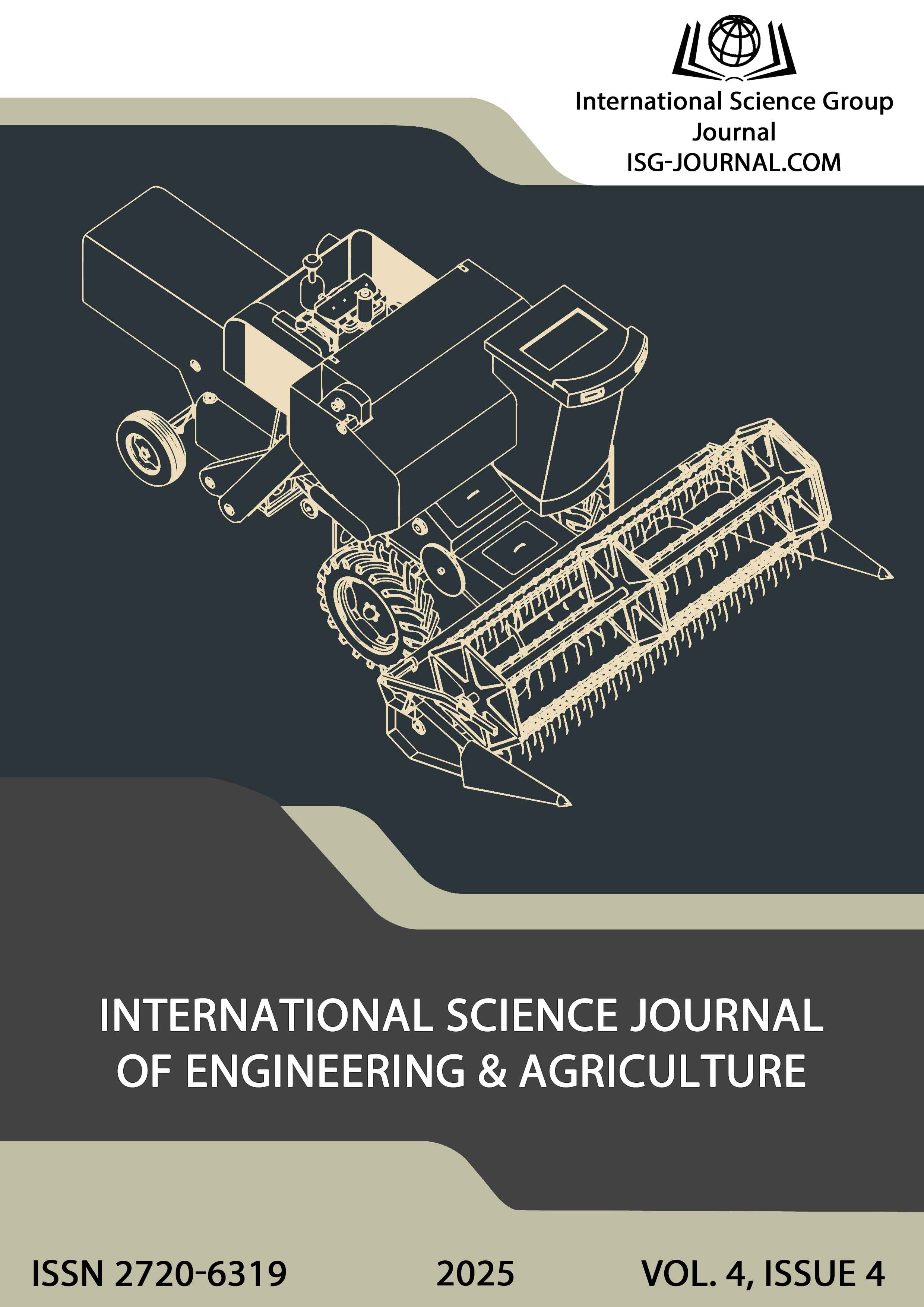Models of sustainable development of industrial facilities in small and medium-sized towns in the Carpathian region
DOI:
https://doi.org/10.46299/j.isjea.20250404.02Keywords:
revitalization, industrial territories, sustainable development, Carpathian region, architectural typology, ecological urbanism, adaptive use, urban planningAbstract
The article examines architectural and urban models of sustainable development of industrial facilities in small and medium-sized cities in the Carpathian region of Ukraine. The topic's relevance is justified in the context of post-industrial transformation of urban structures, environmental challenges, and social vulnerability of local communities. The study aims to identify typological approaches to revitalizing the industrial environment, considering the local context, resource potential, and principles of sustainable spatial development. Three main types of spatial configuration of industrial territories are identified: peripherally isolated, semi-integrated, and integrated. The degree of their inclusion in the urban fabric is analyzed using morphological and grapho-analytical methods. International and domestic practices of adapting industrial objects based on criteria of environmental friendliness, social integration, and architectural heritage are systematized. A typology of architectural and urban revitalization models adapted to the characteristics of the Carpathian region has been developed: integrative, landscape-regenerative, and creative-functional. Each is analyzed according to the principles of spatial intervention, preservation of the structural integrity, flexibility of functional content, and participation of local communities. Examples of domestic initiatives are provided, particularly the Promprylad renovation project. Based on the analysis, conclusions are formulated regarding the critical need to apply a comprehensive, interdisciplinary, and multi-vector approach to adapting industrial territories, considering not only technical and architectural parameters but also cultural heritage values, environmental responsibility, social justice, and spatial inclusiveness. The application of such principles allows not only for the physical transformation of the industrial environment, but also for the formation of a new quality of urban life oriented towards sustainable development.References
Petryshyn, H. P. (2006). Istorychni arkhitekturno-mistobudivni kompleksy: naukovi metody doslidzhennia : navchalnyi posibnyk [Historical architectural and urban complexes: scientific research methods: textbook]. Lviv: Vydavnytstvo Natsionalnoho universytetu «Lvivska politekhnika». 212 s.
Semko, O.V., Voskobiinyk, Ye.P. (2015). Osnovni pryntsypy ta pryiomy rekonstruktsii promyslovykh obiektiv pid budivli hromadskoho pryznachennia [Basic principles and methods of reconstruction of industrial facilities for public buildings]. Zbirnyk naukovykh prats UkrDUZT [Collection of scientific papers of UkrDUTZ]. Vyp. 157. S. 5-13.
Shyshkin, E., Haiko, Y., Viatkin, K., & Pankeieva, A. (2020). Metodyka renovatsii promyslovykh obiektiv roztashovanykh na terytorii mista [Methods for renovating industrial facilities located within city limits]. Mistobuduvannia ta terytorialne planuvannia [Urban development and territorial planning]. (72). P. 288–303. https://doi.org/10.32347/2076-815x.2020.72.288-303
Tate Modern. URL: https://www.tate.org.uk/visit/tate-modern
Zeche Zollverein. URL: https://www.zollverein.de/
Westergas. URL: https://westergas.nl/en/?noredirect=en_US
Landschaftspark Duisburg-Nord. URL: https://www.landschaftspark.de/
Renovatsiia promyslovoi zabudovy ta yii adaptatsiia do suchasnoho miskoho seredovyshcha : monohrafiia [Renovation of industrial buildings and their adaptation to the modern urban environment: monograph] / [Yu. I. Haiko, Ye. Yu. Hnatchenko, O. V. Zavalnyi, E. A. Shyshkin; za zah. red. Yu. I. Haika, E. A. Shyshkina] ; Kharkiv. nats. un-t misk. hosp-va im. O. M. Beketova. Kharkiv : KhNUMH im. O. M. Beketova, 2021. 353 s.
Promprylad. Renovatsiia. Pro proekt [Promprylad. Renovation. About the project]. URL: https://promprylad.ua/ua/project/
Byers, B. S., Raghu, D., Olumo, A., De Wolf, C., Haas, C. (2024). From research to practice: A review on technologies for addressing the information gap for building material reuse in circular construction. Sustainable Production and Consumption. Volume 45. Pages 177-191. https://doi.org/10.1016/j.spc.2023.12.017.
Shao, Y., Binyi, L. (2018). Local Identity Regeneration of Unused Urban Spaces. International Review for Spatial Planning and Sustainable Development. Vol. 6. P. 21-34. URL: https://www.researchgate.net/publication/328291269_Local_Identity_Regeneration_of_Unused_Urban_Spaces
A macro-regional strategy for the Carpathian region. European Parliamentary Research Service. December 2019. URL: https://www.europarl.europa.eu/RegData/etudes/BRIE/2019/642257/EPRS_BRI%282019%29642257_EN.pdf?utm_source=chatgpt.com
Holosenko, A. S., Subin-Kozhevnikova, A. S. (2021). Napriamy renovatsii promyslovykh obiektiv (analiz dosvidu) [Areas of renovation of industrial facilities (analysis of experience)]. Enerhoefektyvnist v haluziakh ekonomiky Ukrainy-2021: materialy mizhn. nauk.-tekhn. konf. [Energy efficiency in the sectors of Ukraine's economy in 2021: materials from the international scientific and technical conference], 23-25 lystopada 2021 r. Vinnytsia. URL: https://conferences.vntu.edu.ua/index.php/egeu/egeu2021 /paper/view/14006.
Berger, S. (Ed.) (2020). Constructing Industrial Pasts: Heritage, Historical Culture and Identity in Regions Undergoing Structural Economic Transformation. 329 р. URL: https://www.jstor.org/stable/j.ctv1850gh6?utm_source=chatgpt.com
Pintossi, N. (2022). Challenges and potential solutions for cultural heritage adaptive reuse: A comparative study employing the Historic Urban Landscape approach. URL: https://pure.tue.nl/ws/portalfiles/portal/205757720/20220706_Pintossi_hf.pdf
Klymenko, M. O., Pylypenko, Yu.V., Moroz, O.S. (2010). Ekolohiia miskykh system : pidruchnyk [Ecology of Urban Systems: Textbook]. Kherson : Oldi-plius. 294 s.
Serhiiuk, I., Kalakoski, I. (2023). Demolition or adaptation?: post-industrial buildings in Ukraine. Buildings and Cities. 4(1). P. 352–368. URL: https://doi.org/10.5334/bc.307.
Тsatsenko Zh. Yak perebuduietsia arkhitektura [How architecture will be rebuilt]. URL: https://skvot.io/uk/blog/how-is-architecture-being-reconstructed.
Kravchunovska, T.S., Bronevytskyi, S.P., Kovalov, V.V., Zaiats, Ye.I. (2017). Osoblyvosti rekonstruktsii promyslovykh pidpryiemstv iz urakhuvanniam mistobudivnoi tsinnosti terytorii [Features of the reconstruction of industrial enterprises, taking into account the urban planning value of the territory]. Stroytelstvo, materyalovedenye, mashynostroenye [Construction, materials science, mechanical engineering]. Vyp. 99. S. 101-106.
Bilous, D. A., Holosenko, A. S., Subin-Kozhevnikova, A. S. (2022). Problemy adaptatsii promyslovykh budivel pid novi funktsii (hoteli) [Problems of adapting industrial buildings to new functions (hotels)]. Suchasni tekhnolohii, materialy i konstruktsii v budivnytstvi [Modern technologies, materials, and structures in construction]. Tom 33 №2. S. 67-72.
Haiko, Yu.I., Hnatchenko, Ye.Yu., Zavalnyi, O.V., Shyshkin, E.A. (2021). Renovatsiia promyslovoi zabudovy ta yii adaptatsiia do suchasnoho miskoho seredovyshcha : monohrafiia [Renovation of industrial buildings and their adaptation to the modern urban environment: monograph]. Kharkiv : KhNUMH im. O.M. Beketova. 353 s.
Downloads
Published
How to Cite
Issue
Section
License
Copyright (c) 2025 Taras Nazaruk

This work is licensed under a Creative Commons Attribution 4.0 International License.






